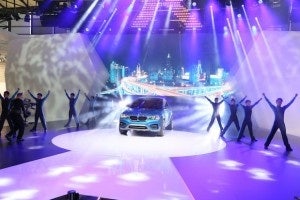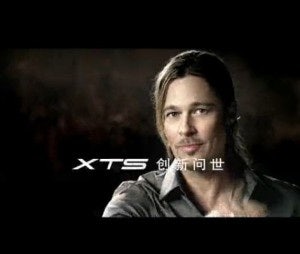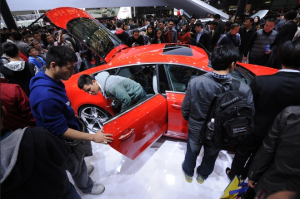Brad Pitt Goes Along For The Ride As Automakers Accelerate#

BMW premieres its X4 model at the 2013 Shanghai Auto Show. (BMW)
This week, Chinese consumers are flocking to the highly anticipated
Shanghai Auto Show#
, where carmakers vie for their attention in a growing yet increasingly crowded market. Judging from the new models unveiled at the show, mainstream luxe brands are buckling up for a year of intense competition as growth slows and more brands strive for increased market share.
Audi currently holds the top spot for mainstream luxury auto sales in China, but competitors BMW, Mercedes-Benz, and Cadillac are all eagerly eyeing the pole position. Although China's luxury auto market is expected to remain on an upward swing until 2020 -- at which point it will have more than doubled -- this year is expected to bring lower growth numbers than 2012. As a result, companies hoping to stake a claim in the burgeoning market face a greater challenge this year.
Even so, some are opting to up their game in hopes of longterm gain.
Volkswagen-owned Audi clearly has a head start, roaring ahead of the pack with a growth figure of 14 percent for the first quarter of this year. By comparison BMW, Audi's current top challenger in China, turned in a more modest 7.5 percent.

A still from the commercial Brad Pitt filmed for Cadillac in China.
Meanwhile, competitors Mercedes-Benz and Cadillac, feeling the need to catch up in the market, are aggressively pursuing China growth strategies this year. Mercedes-Benz, which suffered a vertiginous first-quarter sales drop of 12 percent, has announced plans to increase its dealerships in China from 260 to close to 300, which would rival Audi and BMW's dealership numbers. Mercedes-Benz also plans to introduce 12 new models in the next eight years. Cadillac is also upping the ante with new dealerships, models, and an advertising campaign featuring Brad Pitt.
Mainstream luxury marques may be facing competition from the sportscar elite as well, as ultra-luxury brands downscale in response to the slowdown. At the auto show, Maserati unveiled the new Ghibli, its most inexpensive model on the market. Rather than appealing to ultra-luxury consumers, the Ghibli is expected to compete with such mid-luxe models as the BMW 5 Series, Mercedes-Benz E-Class, and Audi A6.

Chinese consumers check out the Audi S7 at the 2013 Shanghai Auto Show.
But not all ultra-luxury carmakers are pursuing a midmarket strategy. Lamborghini, which sells only around 200 cars in China a year, expects its numbers to remain about the same despite the slowing economy. The company does not plan to expand on its 19 dealerships in the country, or downscale any of its models.
Nor have luxury carmakers stopped responding to the unique demands of the Chinese market. Porsche has rolled out a longer-wheelbase Panamera, with more legroom in the backseat than previous models, targeting a wealthy Chinese clientele who are more likely to have chauffeurs. China's rich also tend to be younger, which has resulted in several car companies crafting new social media marketing campaigns to reach them. It remains to be seen what role social platforms like Weibo and WeChat will have on Chinese car-buying in the future, but automakers are likely to remain competitively creative as the luxury car market becomes more saturated.
